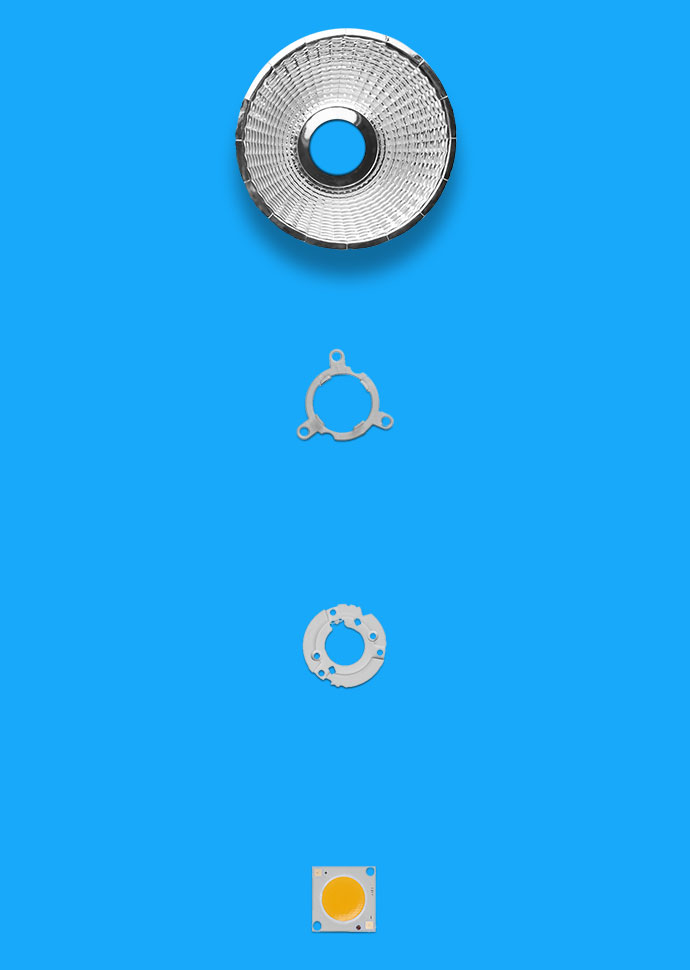
Are allrounders
because they are compatible with all common LED modules
Pave the way
to photometrically sophisticated reflector solutions without any additional expenses for design and tooling
Provide innovation security
by an incessantly updated and extended portfolio
Offer freedom of design
by 3 design sizes: 50 mm / 75 mm / 111 mm
Comprise all beam angle characteristics
from Super Spot to Wide Flood and Oval
Open up energy saving options
by means of the freely available ULTRA-technology with efficiency increases of up to +12% and up to 20% more reflected light compared to conventional reflector technologies
Have a heart for the design-loving and individuals
with µSKIN, the innovative design surfaces

COB-LED (Chip on Board)
In principal COB-LEDs are a number of LED-chips (mostly 9 at least) , which the manufacturer directly fixes to a substrate by means of bonding creating one single module.
As the single LEDs used in COB technology, are chips and usually do not have any enclosure, these chips can be mounted in a space-saving way and reach their maximum potential.
When the COB-LED package is powered, it appears to be a luminous surface rather than single light dots – what would be the case, if you would mount several SMD LEDs close to each other.
Advantages of COB-LEDs
Thanks to the shared enclosure of several LED-chips, the light emitting surface (LES) of a COB-LED can on the same surface contain a multiple of light sources compared to standard LEDs, which leads to a considerably higher light output per square centimetre.
COB-LEDs only need one circuit with just to contacts for the power supply of the numerous diode chips.
The result: For proper oeration less components per LED-chip are needed. Moreover thanks to the reduced number of components and the elimination of separate enclosures of traditional LED-chip structures the heat generated by every single LED-chip can be decreased as well.
The ceramic-/aluminium substrate of COB-LEDs also acts as a heat transfer medium when connecting with an external heat sink, so that consequently the total operating temperature of the sub-assembly is reduced, too.
When fixing a COB module to a heat sink it is absolutely necessary to choose a heat sink that ca dissipate the generated heat in order to be able to fully exploit the COB potential . On long term the proper heat dissipation increaes the efficacy and decreases the failure rate.
Another aspect of COB-LEDs reducing failure rates is the fact that no spot soldering of the single LED-chips is needed. It is not needed, because every chip is mounted directly to the substrate. The lower number of soldering joints leads to the reduction of the failure rate.
The light loss decreases dramatically and the viewing angle is increased – both due to the fact that when using COB-LEDs there are no lenses or other parts of the conventional LED anymore.
COB LED (Chip on Board)
ist eine integrierte Oberflächen-LED-Technologie mit hoher Lichtausbeute, die direkt auf einem metallisches Spiegelsubstrat mit hoher Lichtreflexionsrate auf einem LED-Chip befestigt ist. Diese Technologie eliminiert das Konzept der Halterung und kommt ohne Beschichten, Reflow-Löten und Kleben aus, was den Prozess und die Kosten um fast ein Drittel reduziert. Die COB-LED-Technologie wird hauptsächlich zur Lösung des Problems der Herstellung von Hochleistungs-LED-Leuchten mit kleinen Leistungschips eingesetzt. Sie kann die Wärmeabfuhr der Chips verteilen, die Lichtausbeute verbessern und die Blendungswirkung reduzieren. COB hat eine hohe Lichtstromdichte, weniger Blendung, weiches Licht und emittiert eine gleichmäßig verteilte Lichtfläche.
COB LED kann einfach als leistungsstarke integrierte Oberflächen-LED verstanden werden. Die lichtemittierende Fläche und die Außenabmessung der LED können entsprechend der äußeren Struktur des End-Produkts gestaltet werden.
Merkmale von COB LEDs:
- Elektrische Stabilität, Schaltungsdesign, optisches Design und bessere Wärmeabfuhr sind wissenschaftlich fundierte Vorteile.
- Die Kühlkörpertechnologie wird eingesetzt, um sicherzustellen, dass die LED eine hohe Rate an Wärmestromerhaltung aufweist (95 %).
- COB LED eignet sich für die sekundäre optische Anpassung der LED und verbessert die Beleuchtungsqualität.
- COB hat eine hohe Farbwiedergabe, eine gleichmäßige Beleuchtung und keine Lichtpunkte. Außerdem ist es umweltfreundlich.
- COB ist einfach und bequem zu installieren und zu benutzen. Der Schwierigkeitsgrad des Lampendesigns wird reduziert, und die Kosten für die Lampenverarbeitung und die anschließende Wartung werden eingespart.

